Beit al-Aqad in Damascus: A Hidden Gem of Ottoman-Era Elegance: In the heart of Old Damascus, behind the winding alleys and ancient facades, lies Beit al-Aqad, a beautifully preserved 18th-century Damascene mansion. This historical home is more than just a relic of the past—it is a testament to the city’s architectural, cultural, and diplomatic heritage. Once a luxurious private residence, later transformed into the Danish Institute in Damascus, today it stands as a living monument to art, architecture, and intercultural exchange.
Whether you’re passionate about heritage, architecture, or simply seeking off-the-beaten-path gems in the old city, Beit al-Aqad offers a tranquil and enriching experience.
| Topic | Info |
|---|---|
| Name | Beit al-Aqad / بيت العقاد |
| Location | Old City of Damascus, Syria |
| Date of Origin | Originally built in the 18th century by a wealthy Damascene family |
| Historical Significance | A fine example of a Damascene courtyard house, showcasing the lifestyle and traditions of Ottoman-era Damascus |
| Architectural Highlights | Large central courtyard with fountain, richly decorated qa‘a (reception hall), intricate woodwork, marble panels, alternating black-and-white stone (ablaq style) |
| Current Use | Danish Institute in Damascus, stands as a living monument to art, architecture, and intercultural exchange. |
What Is Beit al-Aqad?
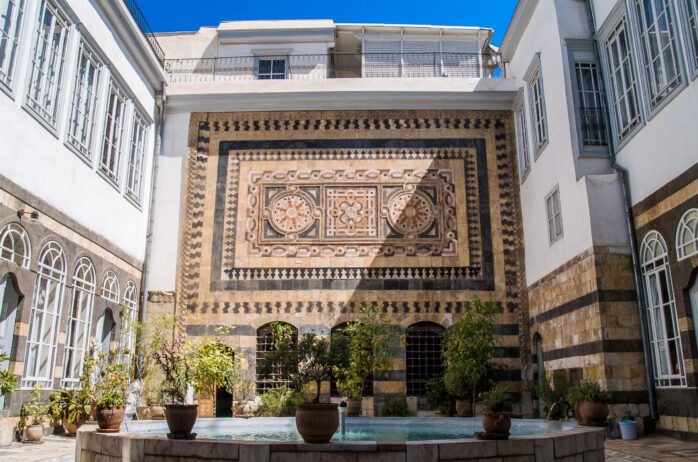
Beit al-Aqad (Arabic: بيت العقاد), or “House of al-Aqad,” is a historic townhouse originally built in the 18th century by the wealthy al-Aqad family, who were prominent textile merchants. The home is a classic example of Damascene architecture, complete with a serene courtyard, richly decorated interiors, and elegant reception rooms.
In the late 20th century, the home was leased to the Danish government, fully restored, and repurposed as the Danish Institute in Damascus, a cultural and academic hub. Though its role has evolved over the years, the building today remains open to visitors, offering both heritage value and cultural programming.
Historical Background
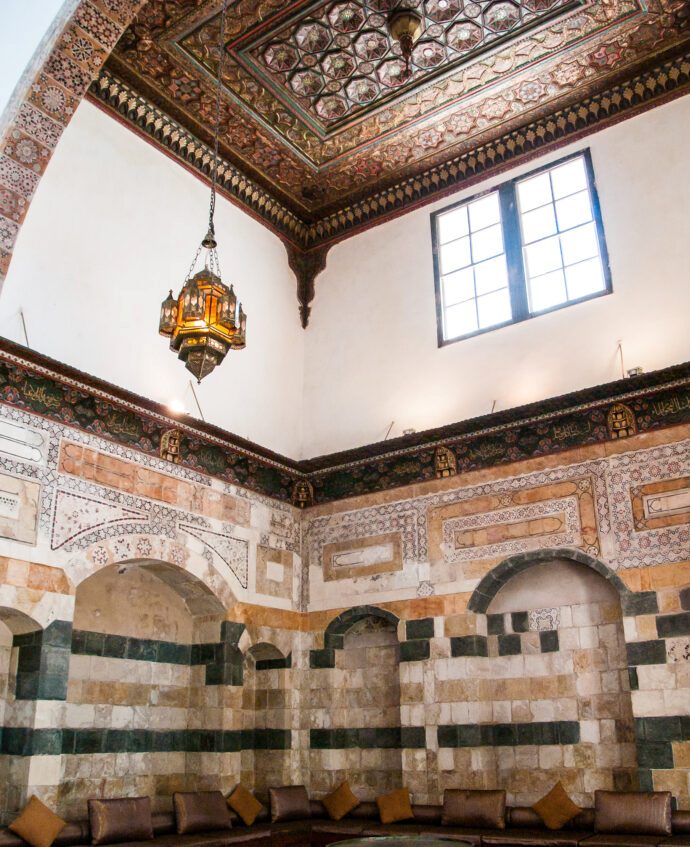
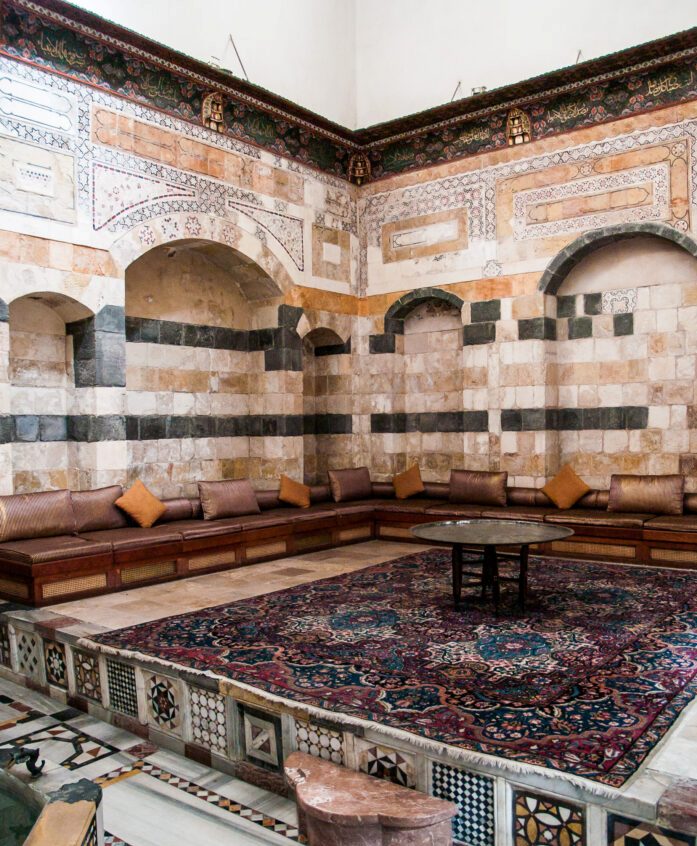
A Legacy of Merchants and Artisans
The house was built during a period when Damascus thrived under Ottoman rule. Wealthy families invested in homes that not only offered privacy and comfort but also reflected their social and financial status. Beit al-Aqad’s original owners, the al-Aqad family, were involved in trade, particularly textiles and spices.
Like many elite homes of the era, the house was designed with meticulous attention to detail, blending luxury with practicality.
From Private Mansion to Cultural Institute
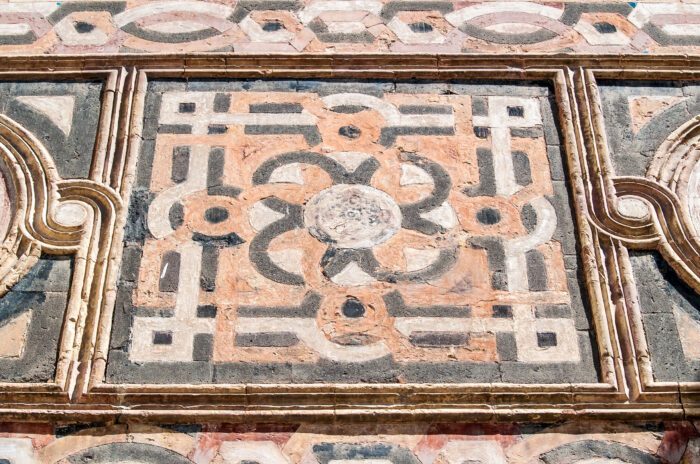
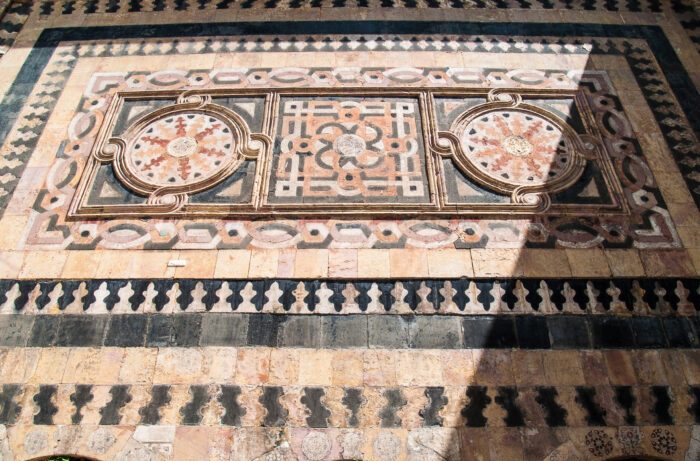
In 1997, the Syrian government signed a 50-year lease agreement with the Kingdom of Denmark, granting access to the building for use as a cultural and academic institute. The Danish Institute in Damascus (Det Danske Institut i Damaskus) was officially inaugurated in 2000 after a meticulous 3-year restoration process, during which the building’s traditional architecture and intricate interiors were carefully preserved.
For more than a decade, it served as a center for cultural exchange, research, and education, hosting artists, scholars, exhibitions, and music events. The Danish Institute played a pivotal role in strengthening ties between Syria and Europe before its activities paused during the Syrian conflict.
A New Chapter
While the Danish cultural programs have since ceased, Beit al-Aqad remains open to the public. The building is still used for cultural events, exhibitions, and heritage-related activities, and is occasionally included in historical walking tours of Old Damascus. Some parts of the house may also be used for training or meetings by heritage and restoration organizations.
Architectural Features

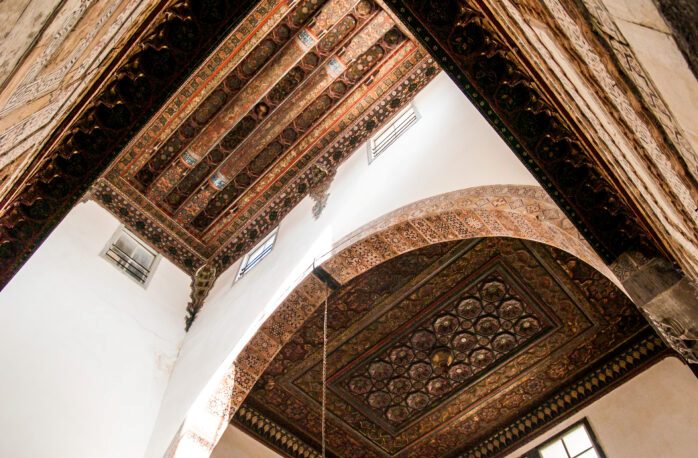
Courtyard and Garden
The soul of Beit al-Aqad is its interior courtyard—a central element in traditional Damascene homes. Surrounded by high walls that shield the inner world from the busy streets outside, the courtyard features:
- A marble fountain
- Citrus and jasmine trees
- Stone benches and elegant paving patterns
- Tranquil shade and birdsong
It offers a peaceful escape that reflects the Damascene way of life: cool, private, and inward-focused.
Ajami Decor and Painted Ceilings
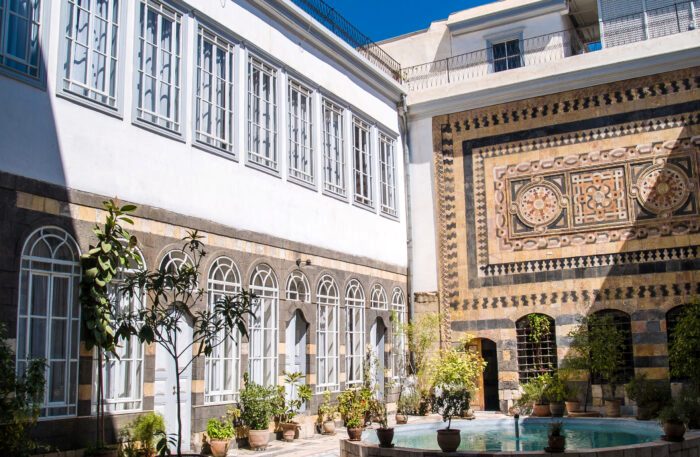
One of the most striking aspects of Beit al-Aqad is its use of Ajami woodwork—hand-carved wooden panels, gilded and painted with floral and geometric patterns in gold leaf, rich reds, greens, and blues. This traditional craft was a hallmark of Damascene luxury homes.
Inside the rooms, you’ll find:
- Ornately painted ceilings
- Inlaid stone floors
- Stained glass windows (qamariyya) filtering soft light
- Calligraphy and Ottoman-Arabesque motifs
The Iwan
Facing the courtyard is the iwan, a vaulted, open-fronted room designed for summer lounging and entertaining guests. Decorated with colorful tiles and elegant archways, the iwan is the most iconic element of Damascene house architecture and Beit al-Aqad’s is particularly well-preserved.
Reception Rooms
The formal guest salons (qa‘a) were used for receiving dignitaries and visitors. These rooms are larger and more lavishly decorated, with seating along the walls, detailed ceilings, and architectural symmetry that reflects Islamic design principles.
Visiting Beit al-Aqad
Location and Access
Beit al-Aqad is located in the Sooq al-Souf (Wool Market) near Khan As’ad Pasha, inside the Old City of Damascus.
- Address: Al-Souf Market, near Bab al-Jabiya and Medhat Pasha Street
- How to get there: It’s a short walk from other major sites like Al-Hamidiyah Souq, Umayyad Mosque, and Bab Touma.
- Opening status: Currently open to visitors
- Entry fee: Free
- Visiting hours: Generally open during daylight hours, but best visited in the morning or as part of a tour
Is a Reservation Required?
No prior reservation is required for general visits. However, for events or group visits, it is best to coordinate through local cultural offices or tour guides.
You can also visit during special events, exhibitions, or European cultural weeks when the building often hosts music concerts, film screenings, or art installations.
Photography and Conduct
Photography is generally permitted, but always ask before taking pictures of specific displays or artwork. As this is a heritage site, be respectful and avoid touching fragile elements such as carved wood or painted surfaces.
Nearby Attractions
While visiting Beit al-Aqad, you can easily explore other historic sites nearby:
- Khan As’ad Pasha: A stunning 18th-century caravanserai
- Al-Hamidiyah Souq: Damascus’s most famous market street
- Umayyad Mosque: One of the oldest and largest mosques in the world
- Straight Street (Via Recta): The ancient Roman road
- Beit Nizam and Beit Jabri: Other preserved Damascene houses
Why It Matters
A Cultural Bridge
Beit al-Aqad is more than a beautiful building—it served as an important cultural bridge between Syria and Denmark, and more broadly between the Arab world and Europe. Its preservation and adaptation into the Danish Institute was a remarkable act of cultural diplomacy.
A Model of Preservation
Unlike many traditional homes that have been turned into restaurants or hotels, Beit al-Aqad has retained its authentic layout and decor. Its careful restoration and respectful use make it a model of sustainable heritage conservation.
A Peaceful Encounter With History
While many tourist spots in Damascus can be lively and bustling, Beit al-Aqad offers a quiet, contemplative space. Here, visitors can slow down, take in the details, and imagine life in 18th-century Damascus.
Final Thoughts
Beit al-Aqad is one of the most enchanting and underappreciated heritage sites in Old Damascus. Whether you are an architect, artist, historian, or just a curious traveler, walking through its ornate halls and peaceful courtyard offers a timeless experience.
Though its role has changed—from private mansion to Danish cultural institute to public heritage site—its heart remains the same: a space of beauty, dialogue, and cultural pride.
If you’re wandering the alleys of Old Damascus, don’t miss the opportunity to step inside. Beit al-Aqad doesn’t just tell the story of a house—it tells the story of Damascus itself.
Finally.. If you have any questions, please contact us. To explore further, visit our Facebook Syria collection for rare images and cultural highlights.
Sources & References:
UNESCO – World Heritage Centre: https://whc.unesco.org
Archnet – Architecture & Heritage Database: https://www.archnet.org
World History Encyclopedia: https://www.worldhistory.org
Syrian Heritage Archive Project: https://syrian-heritage.org
Global Encyclopedia: Wikipedia



